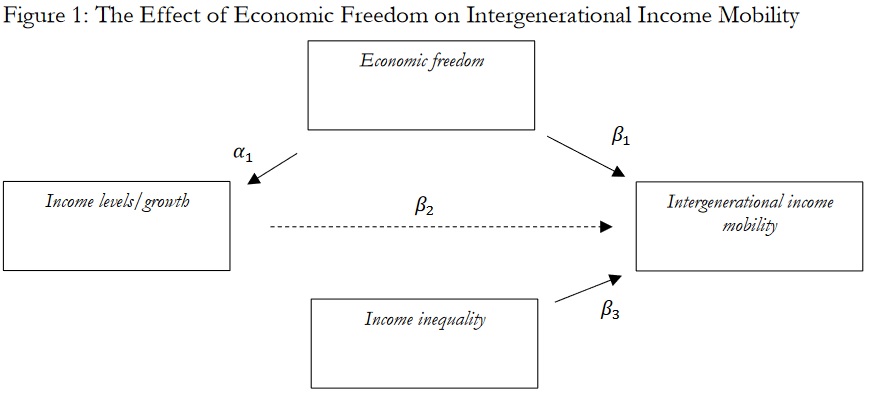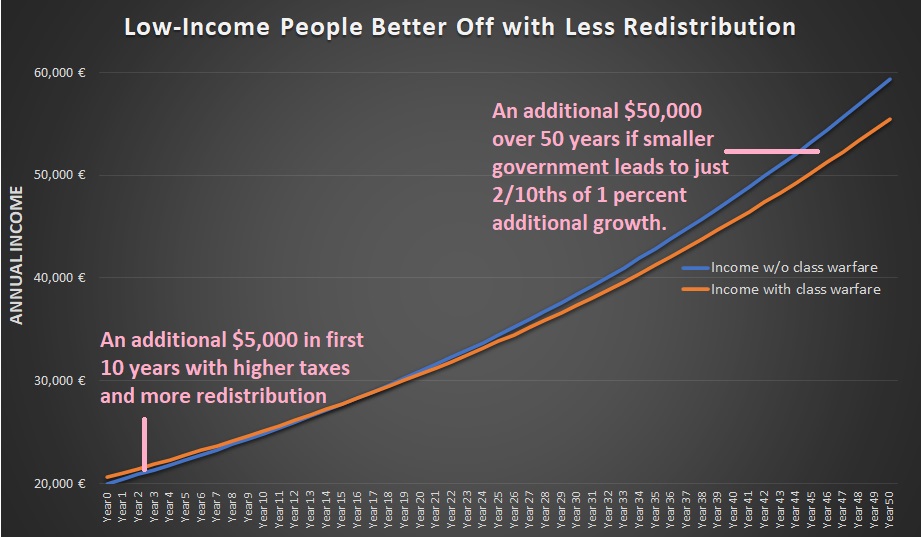Back in May, as part of a discussion about the tradeoff between free markets (efficiency) and redistribution (equity), I put together a chart to show how poor people are better off in the long run if policy makers focus on the former rather than the latter.
I made sure to assume that pro-market policies would generate only a small increase in growth.
However, thanks to “the miracle of compounding growth,” even that tiny increase results in the poor being better off when compared to a world with less growth and more redistribution.
But I was just providing a theoretical example, and it would be easy to change some assumptions to show that the poor would have better lives (as measured by consumption levels) with bigger government.
Fortunately, there’s a new study, authored by Justin Callais of Texas Tech University and Vincent Geloso of George Mason University, that looks at hard data to see which approach is best for poor people.
Here’s a description of their methodological approach, which uses the positive liberty vs negative liberty construct.
While it is true that economic freedom speaks directly to negative liberty, it also speaks indirectly to positive liberty because of its well–documented effects on economic growth, health outcomes and education. …We build on these works by using a rich dataset of estimates of income mobility of people born in the 1980s. …the dataset employed includes a larger number of poor and rich countries. Combining these data with those of the Fraser Institute’s Economic Freedom of the World (henceforth EFW) index, we try to measure its indirect effect (through growth and income levels) on intergenerational income mobility in a horse race with income inequality.
For all intents and purposes, they want to see which effect dominates in this flowchart.

And here’s the way they describe the chart.
…the true effect of economic freedom on intergenerational mobility is 𝛽1 + 𝛼1𝛽2. As long as 𝛽1 + 𝛼1𝛽2 > β3, economic freedom’s effects outweigh those of income inequality on positive liberty (as intergenerational income mobility is a stand–in for positive liberty).
So what did they find?
We find that economic freedom has both a direct and indirect effect on intergenerational income mobility. More importantly, those effects are more important than those of income inequality. We argue that our results militate for the claim that good institutions matter more to securing positive liberty than income redistribution does. …we find that the lifetime institutional environment is a strong predictor of incomes today. The indirect effect of economic freedom (through income levels) on mobility is again strong and negatively correlated (indicated greater income mobility). …economic freedom has both a direct and indirect effect on intergenerational income mobility. …Economic freedom provides the legal right to engage in commerce, but through economic freedom’s impact on income, the institutional environment speaks to increasing the practical and realistic choice sets of people to better their situation.
The bottom line is that the poor are better off with economic freedom (i.e., negative liberty). Free markets lead to more upward mobility and higher living standards.
So if you want less poverty, push for more capitalism.
———
Image credit: Erik Scheel | Pexels License.



